|
Joint zones, also known as swarms, clusters, or corridors, are a series of closely spaced joints separated by relatively wider unfractured or less fractured slabs of rocks. They show a wide variability in geometry and dimension as well as genesis. Perhaps one of the well known examples of joint zones occurs in the Jurassic sandstone exposed at the flanks of the Salt Valley anticline at Arches National Park (Dyer, 1979; 1983). There, joint zones which are expressed by negative relief due to faster erosion along them, can be easily identified on an aerial photograph (Figure 1).
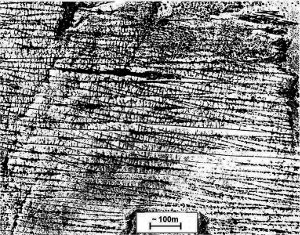 | | Figure 1. Aerial photograph of an area on the northeastern flank of the Salt Valley anticline, Arches National Park (Utah) showing morphological expression of joint zones along the primary set sub-parallel to the axis of the anticline. From Dyer (1979). |
The spacing of the zones is comparable with the thickness of the Moab member of the Entrada Sandstone in which they occur (Figure 2). These joint zones, each of which includes only a small number of overlapping joints, extend many kilometers sub-parallel to the strike of the bedding or the axis of the anticline.
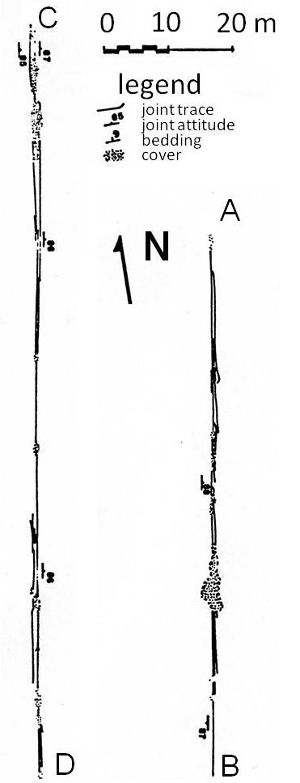 | | Figure 2. Map showing the details of neighboring zones and their spacing. From Dyer (1983). |
Figure 3 shows cross sectional views of an array of rather broader joint zones exposed along the sandstone cliff faces in Scotland (Maerten, 1996). Figure 4 shows scanline data of joint spacing quantifying joint spacing and joint clustering in the Pictured Cliffs Sandstone exposed near Durango, Colorado (Laubach, 1991). These joint zones have less regular geometry than those in Figures 1, 2, and 3, and include many individual joints at a trend different than the more systematic primary ones with the implication of shearing in the evolution of the joint zones. As mentioned in other places in this Knowledgebase, most joint zones are prone to shearing across them due to their weakness with respect to less fractured surrounding rock slabs.
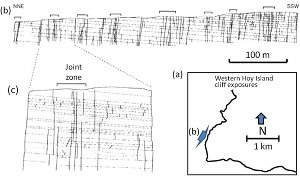 | | Figure 3. Joint zones along the coast of Western Hoy Island, Orkney Islands, Scotland (see 1a for location). (b) shows a series of joint zones in the Old Red Sandstone exposed along the cliff mapped on a mosaic of photographs. (c) A single isolated joint zone. From Maerten 1995. |
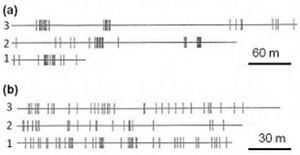 | | Figure 4. Joint zone spacing measured along three scanlines (1, 2, 3) in (a) the Pictured Cliffs and (b) the Frontier sandstones. From Laubach (1991). |
Joint zones and their distributions have also been studied systematically by Florez-Nino et al. (2005) and the distribution of the joint zones are given in Figure 5 and Figure 6. A similar study by Cilona et al. (2006), which includes the spacing distribution of joints and joint zones together with the spacing of fault zones, is presented under the sub-class of fault zones.
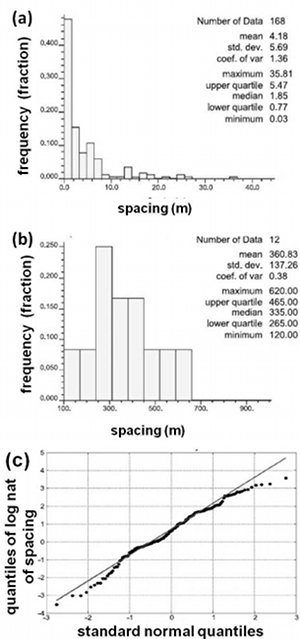 | | Figure 5. Distribution for slightly sheared joint zones in the Huamampampa sandstone stratigraphic sequences (a) and fault zones (b) in the entire Huamampampa Formation cropping out along the backlimb of the Abra del Condor anticline, Andean fold and thrust belt in southeastern Bolivia. A quantile-quantile plot of spacing versus log-natural plot of spacing in (c) shows that the spacing distribution of sheared joint zones or faults has log-normal form. From Florez-Nino et al. (2005). |
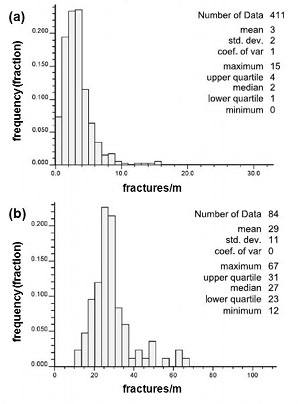 | | Figure 6. Fracture density distributions for low-density (a) and high-density fracture zones (b). The low-density fracture zone is likely to be dominated by initial joint zone and has log-normal form; the high-density zone is definitely modified by shearing and has normal distribution with nearly symmetric clustering in the middle range. From Florez-Nino et al. (2005). |
| |
Cilona, A., Aydin, A., Likerman, J., Parker, B., Cherry, J., 2016. Structural and statistical characterization of joints and multi-scale faults in an alternating sandstone and shale turbidite sequence at the Santa Susana Field Laboratory: Implications for their effects on groundwater flow and contaminant transport. Journal of Structural Geology 85: 95-114, http://dx.doi.org/10.1016/j.jsg.2016.02.003.
Dyer, J.R., 1979. The origin and mechanisms of jointing in sandstone. Stanford Rock Physics Project 7: 1-24.
Dyer, J.R., 1983. Jointing in sandstones, Arches National Park, Utah. Ph. D. Dissertation, Stanford University, 202 p.
Florez-Nino, J.M., Aydin, A., Mavko, G., Antonellini, M., Ayaviri, A., 2005. Fault and fracture systems in a fold and thrust belt: An example from Bolivia. American Association of Petroleum Geologists Bulletin 89: 471-493.
Laubach, S.E., 1991. Fracture Patterns in Low-Permeability-Sandstone Gas Reservoir Rocks in the Rocky Mountain Region. SPE Special paper 21853.
Maerten, L., 1995. Methodology to estimate the small-scale fracture distributions in reservoirs using outcrop mapping and mechanical modeling. Stanford Digital Repository. Available at: http://purl.stanford.edu/nq037tm6874.
|





